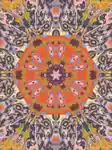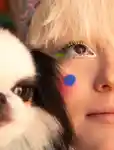
Libby Sellers: Bethan, we’re looking at this magnificent portrait by your long-term collaborator, London-based photographer Mark Cocksedge. You appear enveloped in a world of layered textiles, patterns, and colours – a living artwork seated within a tapestry or tableaux of your own making. What was your intention with this image?
Bethan Laura Wood: We really wanted to blur the boundaries between the subject or foreground and its background here. It’s more a still life, or a study in layers, than a portrait. But also, it reminds me of a Pre Raphaelite painting. Both texturally and notionally. Rather than me being the subject of the gaze, my gaze becomes the subject. I like that I’m in charge, inviting the viewer on a journey and into my dreamscape.
LS: Every textural fold, clash of pattern, and flick of eyeliner, feels like a deliberate orchestration, an act of storytelling through material, application and visual excess. Where or how do we begin to unravel these layers?

Libby Sellers: Bethan, we’re looking at this magnificent portrait by your long-term collaborator, London-based photographer Mark Cocksedge. You appear enveloped in a world of layered textiles, patterns, and colours – a living artwork seated within a tapestry or tableaux of your own making. What was your intention with this image?
Bethan Laura Wood: We really wanted to blur the boundaries between the subject or foreground and its background here. It’s more a still life, or a study in layers, than a portrait. But also, it reminds me of a Pre Raphaelite painting. Both texturally and notionally. Rather than me being the subject of the gaze, my gaze becomes the subject. I like that I’m in charge, inviting the viewer on a journey and into my dreamscape.
LS: Every textural fold, clash of pattern, and flick of eyeliner, feels like a deliberate orchestration, an act of storytelling through material, application and visual excess. Where or how do we begin to unravel these layers?

BLW: Beauty, makeup, pattern and decoration – they’ve always been my tools for escapism and storytelling, both personally and professionally.
In relation to my work, I often use the phrase ‘distance through detail’– the many layers (like marquetry or applique), the mix of patterns and materials offer portals into other worlds, other histories, and other cultures. Though this portrait also has much of my own history in it: my favourite possession – a daybed by Natalie du Pasquier and George Sowden, some of my textile based works for Moroso and Tangerine, one of my Totem lights (akin to my recent chandelier for MECCA’s flagship in Melbourne), a dress from Zandra Rhodes’ personal archive reserved specifically for me, and a snippet of my Kaleidoscope-o-Rama Carpet – part of the design universe born from my 2023 MECCA x NGV Women in Design commission.

LS: Let’s talk more about that commission, The Kaleidoscope-o-rama Bookcase, and how it relates to our conversation about beauty. At the time, your research involved delving into the Bluestocking Society – one of the first British feminist groups. Their mid-18th century gatherings (typically in homes and domestic spaces) encouraged an open dialogue about literature, the arts and philanthropy. These salons invited an inclusive approach to education, and ultimately to female agency. Yet the Bluestockings weren’t without their detractors. Criticised for being bookish, their contemporaries decried books ‘frazzled female brains and damaged their wombs.’ What would a Bluestocking’s take on beauty have been?
BLW: My understanding is that most Bluestocking women embraced their femininity – the ribbons, adornment and decoration. For them, beauty and femininity were tools, helping allay any threat posed by their self-development, educational agenda or rebellious interests. They likely leant into traditional notions of femininity to avoid the criticism.

LS: Let’s talk more about that commission, The Kaleidoscope-o-rama Bookcase, and how it relates to our conversation about beauty. At the time, your research involved delving into the Bluestocking Society – one of the first British feminist groups. Their mid-18th century gatherings (typically in homes and domestic spaces) encouraged an open dialogue about literature, the arts and philanthropy. These salons invited an inclusive approach to education, and ultimately to female agency. Yet the Bluestockings weren’t without their detractors. Criticised for being bookish, their contemporaries decried books ‘frazzled female brains and damaged their wombs.’ What would a Bluestocking’s take on beauty have been?
BLW: My understanding is that most Bluestocking women embraced their femininity – the ribbons, adornment and decoration. For them, beauty and femininity were tools, helping allay any threat posed by their self-development, educational agenda or rebellious interests. They likely leant into traditional notions of femininity to avoid the criticism.
LS: Like a trojan horse?
BLW: They were challenging 18th century norms. Yet they did so while working within that same societal structure. Women couldn’t own anything then – they weren’t permitted a bank account; to own a house… their sense of self was possibly the only thing they could control and, even then, that was moderated by men, or by society’s expectations.
My introduction to the Bluestocking Society was a cartoon from the satirical magazine Punch. It depicted these learned women as raucous, brightly coloured and unruly, almost grotesque. In homage (or as rebellion), I embraced all those qualities of colour, pattern, idiosyncrasy… and turned perceived negatives into a powerful, positive design language. Sometimes the way to take control of the narrative is to reclaim what is said, to turn the negative into a force for empowerment. It’s a celebration of more, rather than less. There is a link to be made here between my work and makeup choices.
LS: Nice pivot! Can you explain further?
BLW: Makeup has a rich and nuanced history as a tool for identity, expression and culture. As a young girl, I experimented with mascara, lipsticks and eyeliner. But unlike my contemporaries, I wasn’t applying the lipstick, eyeliner, etc. to the same areas of my face. Even back then, I liked the idea of subverting or taking control of a certain set of systems and repurposing them for my own needs. And that’s the crossover.
In my work, I take the tools, systems or materials created for a specific purpose, discipline or environment then abstract them, utilising them in different ways outside of their intended norm. I use industrial components for their expressivity rather than their standardisation. Look at my work with laminates or Pyrex. Both scientific, manufactured materials; both primarily used in the kitchen. Yet I repurpose them in my design works, challenging their proposed industrial intent while still honouring the fact they’re man-made materials. I love that contradiction. Pyrex normally comes in regular diameters and tubes – very clinical. Rather than hide those restrictions or qualities, I build the brief or language of the work around them.
LS: The idea of empowerment is a recurring theme in our discussions. Can we conclude this with another comment on your own personal empowerment in relation to beauty?
BLW: I've always used makeup and dress to express my identity. Though in the past, when I was still discovering my identity as a designer, I didn't like the associations made between my look and my work. As I became more self-assured in both, I began appreciating the crossover. Through images like this collaboration with Mark, I've found a way to empower my choices around expression and identity; a positive way to connect my work and my personal aesthetic. I’ve now completely reclaimed them and take confidence in them.

Bethan Laura Wood, Kaleidoscope-o-rama (excerpt), colour digital animation, 2023. Creative director: Benjamin Ducroz, Digital animation: James Josephides. Commissioned by the National Gallery of Victoria, Melbourne, through the MECCA x NGV Women in Design Commission.
LS: The idea of empowerment is a recurring theme in our discussions. Can we conclude this with another comment on your own personal empowerment in relation to beauty?
BLW: I've always used makeup and dress to express my identity. Though in the past, when I was still discovering my identity as a designer, I didn't like the associations made between my look and my work. As I became more self-assured in both, I began appreciating the crossover. Through images like this collaboration with Mark, I've found a way to empower my choices around expression and identity; a positive way to connect my work and my personal aesthetic. I’ve now completely reclaimed them and take confidence in them.

Bethan Laura Wood, Kaleidoscope-o-rama (excerpt), colour digital animation, 2023. Creative director: Benjamin Ducroz, Digital animation: James Josephides. Commissioned by the National Gallery of Victoria, Melbourne, through the MECCA x NGV Women in Design Commission.

Bethan Laura Wood is a London-based designer known for her vibrant, multi-disciplinary practice exploring materiality, colour, and cultural narratives. She’s collaborated globally with partners including Dior, Hermes, Moroso, Perrier–Jouët and was the recipient of the 2023 MECCA x NGV Women in Design commission. Her work, held in major museum collections, bridges art, design, and sustainability with joyful curiosity.
Libby Sellers is an independent design curator and writer.

Bethan Laura Wood is a London-based designer known for her vibrant, multi-disciplinary practice exploring materiality, colour, and cultural narratives. She’s collaborated globally with partners including Dior, Hermes, Moroso, Perrier–Jouët and was the recipient of the 2023 MECCA x NGV Women in Design commission. Her work, held in major museum collections, bridges art, design, and sustainability with joyful curiosity.
Libby Sellers is an independent design curator and writer.

The History of Beauty
A timeline of the moments that defined beauty culture from the 1900s to now.

The Art of Seeing Beauty
Katy Hessel reframes beauty through untold stories in art.

On Making History
A message from Vogue's first Indigenous Australian cover model, Elaine George.